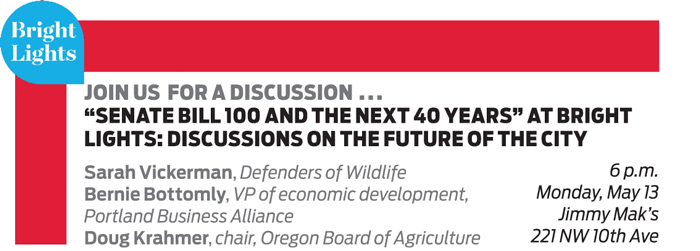Pushing Boundaries
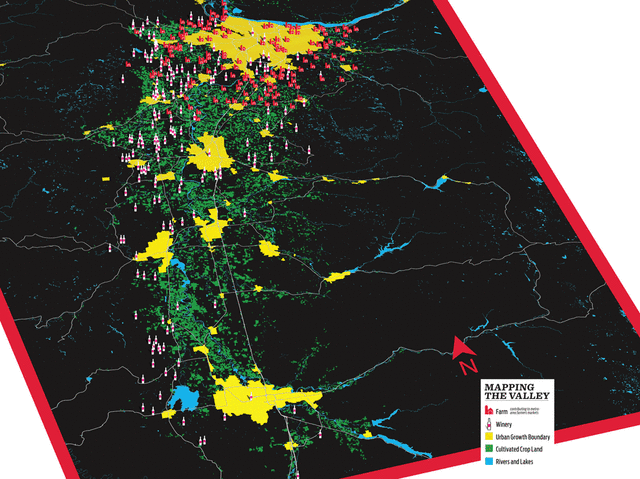
Mike and Debbie Duyck own a 50-acre farm that straddles a northbound road just a short walk from the city limits of Cornelius at the base of the Coast Range. On one side, they graze and milk 40 dairy cows. On the other, they grow vegetables for a summer roadside stand. But in 2011, the strip of asphalt dividing their land turned into a battle line. The City of Cornelius designated one side of Cornelius-Schefflin Road as “urban reserves”—land for future development.
Mike Duyck says he’d like to continue farming both sides of the land his parents bought in 1957. “How do you farm on one half and have houses and industry on the other half?” he asks. When land moves from “rural” to “urban” on planners’ maps, the clock toward eventual development starts ticking.
The fate of the Duycks’ farm and 28,615 other acres of new urban reserves designated across the region has bounced between city and county governments, Metro, and the state for over two years. Oregon’s Court of Appeals is poised to decide the matter in the coming weeks—ironically in near perfect timing with the 40th birthday of Oregon’s unique process of drawing firm lines between its farmland and cities.
In May 1973, the Oregon Legislature passed Senate Bill 100, the landmark law mandating that every city in the state begin to manage its growth. Before the bill, wide swaths of the state’s rural lands were zoned for 5- and 10-acre lots, prime for the kind of estate homes and farmettes that colonized rural land across the country. After the bill, top-grade farmland earned protective zoning and strict caps on property taxes.
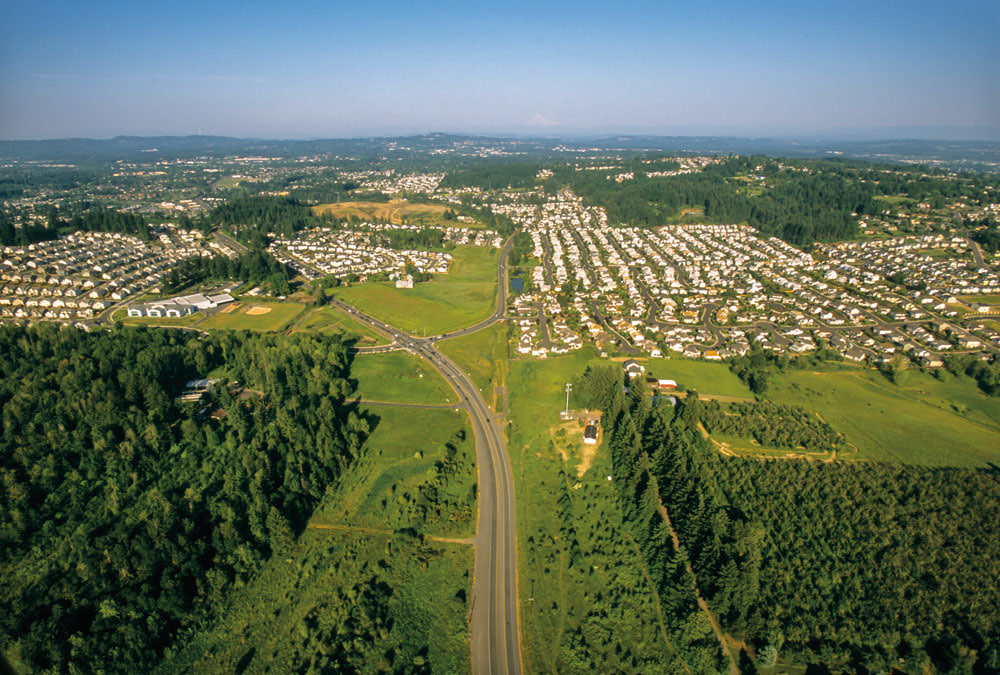
At SW Scholls Ferry Road and 175th Avenue, the city of Tigard ends in a messy edge, but an edge nevertheless: the metro region’s urban growth boundary.
Image: Courtesy Bruce Forster
Without SB100, much of Sauvie Island would have almost certainly been carved into home sites. Early Oregon vintners experimenting with pinot noir grapes would have had to compete with homebuilders for the sunny, south-facing view sites of the Dundee Hills. The quick farm-to-table commute for fresh vegetables and proteins, which made Portland’s ingredient-obsessed food scene the talk of the country, would almost certainly be longer and less direct.
Yet as the state’s professional planners prepare to stage a gala celebration of SB100’s 40th on the very day it was signed—May 29—some of them argue the system the law created now needs dramatic change.
“Senate Bill 100 was one of greatest planning experiments that we’ve had in this country in the last 40 years,” says Nohad Toulan, founder of Portland State University’s esteemed College of Urban and Public Affairs. “But is the current system sufficient? My answer is no.”
Since the first pioneers wandered down the Oregon Trail, incoming Oregonians have chosen the Willamette Valley over other parts of the state. Toulan’s research shows the pattern of settlement has barely changed throughout the state’s history. In 1870, 90,000 people populated the state, 81 percent of them in the fertile 15-county region bracketing present-day I-5. In 2010, 3.8 million people lived in Oregon, 3.1 million of them in those counties—82 percent. Project the same proportions ahead at Oregon’s average growth rate of 1 percent each year, and by 2040 the 15 counties will have 4.5 million residents. By 2100, they will have 10 million.
Gov. Tom McCall’s “Project Foresight” laid out two visions for a million new residents: one without planning and one with it.
And if doomsday scenarios about global warming come true, Toulan warns, “We will be the lucky ones here. We still have water—maybe not what we’ll need, but far more than our Southwestern neighbors.”
“So what is going to happen in the next 90 years?” he asks. “Nothing will be different, if we continue doing what we’re doing.”
Toulan believes that as effective as SB100 has been in reining in sprawl, the system the legislation spawned is too steeped in the state’s agrarian past to deal with the dramatically more urban world to come. He and Arnold Cogan—who, as the state’s planning coordinator in the ’60s and ’70s, played midwife to SB100’s birth—are arguably the two most respected planners in the state, and they’re making an impassioned plea for what they believe is now needed: a state-level strategic plan to deal with the big changes ahead.
Indeed, it was this kind of wide-angle, long-range view of the valley’s future that produced SB100 in the first place.
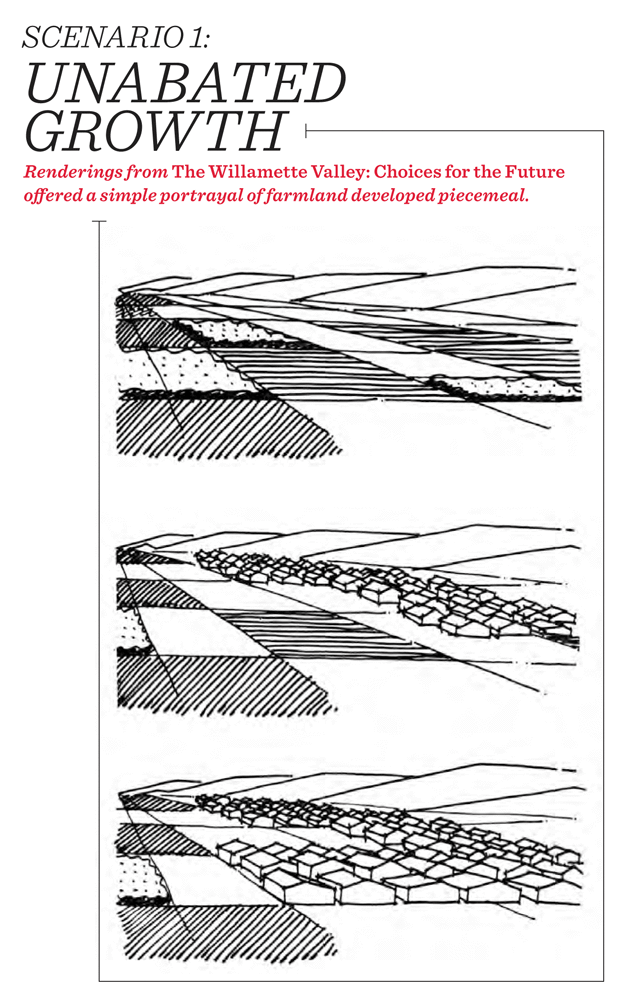
Stories abound of Gov. Tom McCall’s quippy salesmanship of SB100. (“We need growth,” he warned, “but not the chain-letter type that leaves future generations with an empty mailbox.”) History buffs and political insiders still marvel at the brilliant farmer and Republican state senator Hector Macpherson’s acumen in shaping the actual legislation, and liberal urban senator Ted Hallock’s hammering together of the deals that got the bill passed.
But the research and outreach campaign McCall conducted for two years before has largely faded from memory for all but those who were there. Known as Project Foresight, it involved a deep analysis of the Willamette Valley’s future: population trends, projected traffic and air pollution levels, energy demands, and recreation needs. Prefaced with a personal letter from McCall, Project Foresight began with a poll to 50,000 residents of the Willamette Valley asking them simple, direct questions on what about the valley they valued and what their state government should prioritize.
The research and polling effort culminated in a study by the San Francisco landscape architecture firm Lawrence Halprin and Associates called The Willamette Valley: Choices for the Future. It plainly laid out two scenarios for the coming 30 years, one with the expected 1 million newcomers sprawling across the valley in those 1-, 5-, and 10-acre lots, the other with new development compactly focused in existing cities and new town centers arrayed along commuter rail lines. The document, 41 years old now, marks the first appearance of “transit-oriented” development—a guiding ethos ever since—in an Oregon plan. With its colored-pencil, bird’s-eye view of the valley for a cover, typewriter text, and hand renderings of sprawl and more compact growth, the 112-page, 11-by-14-inch book recalls simpler, more idealistic times. McCall’s lead staffer on the project, Bob Logan, even unveiled the book at a meeting of 600 elected officials, businesspeople, farmers, and activists to the Cat Stevens song “Where Do the Children Play?” And Halprin’s team conducted more than 275 town-hall-style meetings across the valley with a 200-image slide presentation.
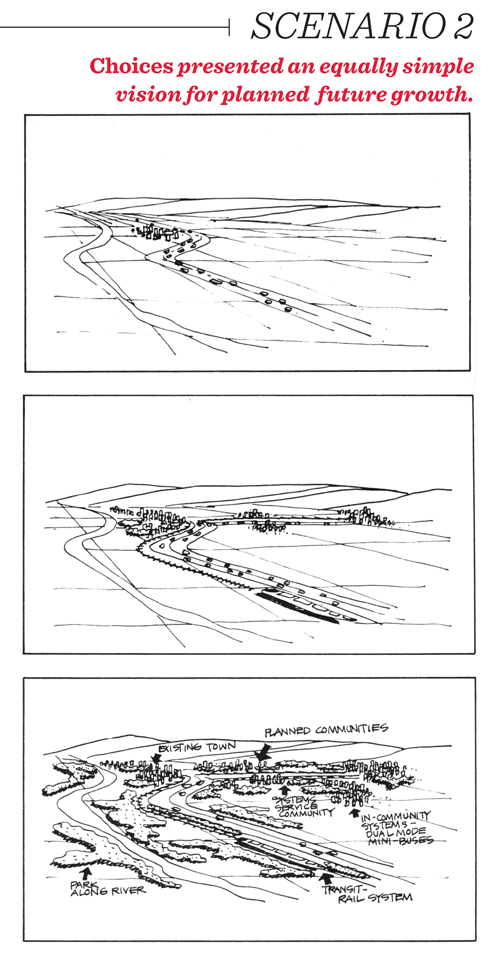
“Thousands of people came to those meetings and chewed on the idea of two paths to growth,” Cogan says. “It really built a groundswell of public support for a stronger approach to growth controls.”
By some measures, it worked: in the pre-SB100 world of 1969, the seven counties at the heart of the Willamette Valley boasted 1,539,978 acres of cultivated crops. In 2007, the latest figures available, the valley had 1,240,571 acres in production—a loss of just 20 percent. Clark County, just across the Columbia River, by contrast, lost 37 percent of its farmland over the same period.
But bringing land into the urban growth boundaries has been slow, litigious, and, often, economically ineffective. The largest expansion of Metro’s boundary—13,000 acres in Damascus envisioned as an eventual compact satellite city with a town center and nearby factory district surrounded by housing—spawned many political battles, but virtually no new development. Oregon City’s last expansion remains fallow because voters turned down annexation of the land. Despite vying for hundreds more acres in this round of expansions, Cornelius has yet to develop—or even annex—the new land it won the last time the boundaries changed. Meantime, land for new industrial development easily connected to existing roads and utilities remains limited.
SB100 grew from an era in which agriculture and timber dominated Oregon’s economy. Logically, protection of productive land was the highest priority, observes Duncan Wyse, president of the Oregon Business Council. Two things have changed: the economy is mostly urban, and protecting natural habitat is now a critical priority.
Bringing land into the urban growth boundaries has been slow, litigious, and, often, economically ineffective.
“Back then we gave very little thought to how urban areas work economically or how critical habitats function,” Wyse says. “With all the benefits of the present system, we have basically one tool: land regulation. There are other tools—land swaps, conservation easements, infrastructure placement—that have been used to great effect elsewhere over the last 30 years that we don’t think much about.”
Poised on the line of uncertainty between both the agriculture and the cities the Willamette Valley needs for the future, farmer Mike Duyck puts his dilemma succinctly: “You can’t do any long-range planning.” So, too, the state. At a recent international conference, Toulan and Cogan presented a paper titled “The Next 40 Years,” calling for Oregon to create a new state planning office and a “Commission for the 22nd Century.” Within four years, they argued, the state should develop a strategic plan for the next 40 years and beyond, coordinating policies for everything from transportation and environmental quality to investment and seismic safety. With shades of McCall’s vision and Halprin’s penetrating study, the effort would focus on “the general health and well-being of the entire state.”
Without a wider, deeper look at the future, says Toulan, “we will go from one crisis to another because of the disconnect between what we are trying to do and the economic realities.
“When we talk about planning, we need to get out of our obsession that it is only about land use. We need to integrate economic and social concerns and demographic analysis and look to the future and ask, what do we want?”
